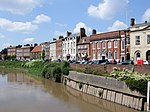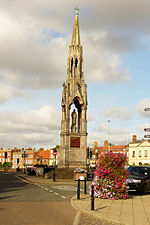Wisbech East railway station

Wisbech East was a railway station in Wisbech, Cambridgeshire. It was opened in 1848 and became part of the Great Eastern Railway network, providing connections to March, Watlington and St Ives, as well as Upwell via the Wisbech and Upwell Tramway. The station closed in 1968 and no trace of it remains today. A freight-only line remains extant as far as a factory based in the station's former goods yard, and a heritage railway based in March is aiming to reinstate services to Wisbech and construct a new station as near as possible to Newbridge Lane crossing. In June 2009 the Association of Train Operating Companies published a report indicating that the reopening of the line to Wisbech and construction of a new station could be viable, in that the ratio of business, economic and social benefits to costs would be just over £1m.
Excerpt from the Wikipedia article Wisbech East railway station (License: CC BY-SA 3.0, Authors, Images).Wisbech East railway station
Railway Road, Fenland District
Geographical coordinates (GPS) Address Nearby Places Show on map
Geographical coordinates (GPS)
| Latitude | Longitude |
|---|---|
| N 52.6585 ° | E 0.159 ° |
Address
Railway Road 1
PE13 2UP Fenland District
England, United Kingdom
Open on Google Maps








